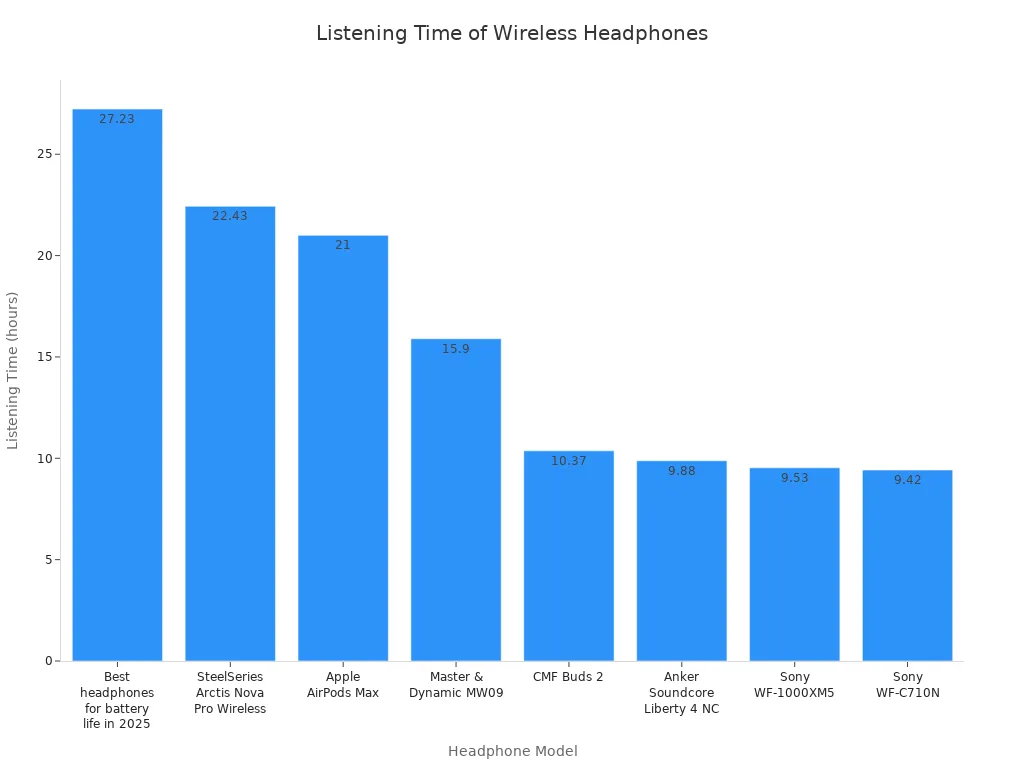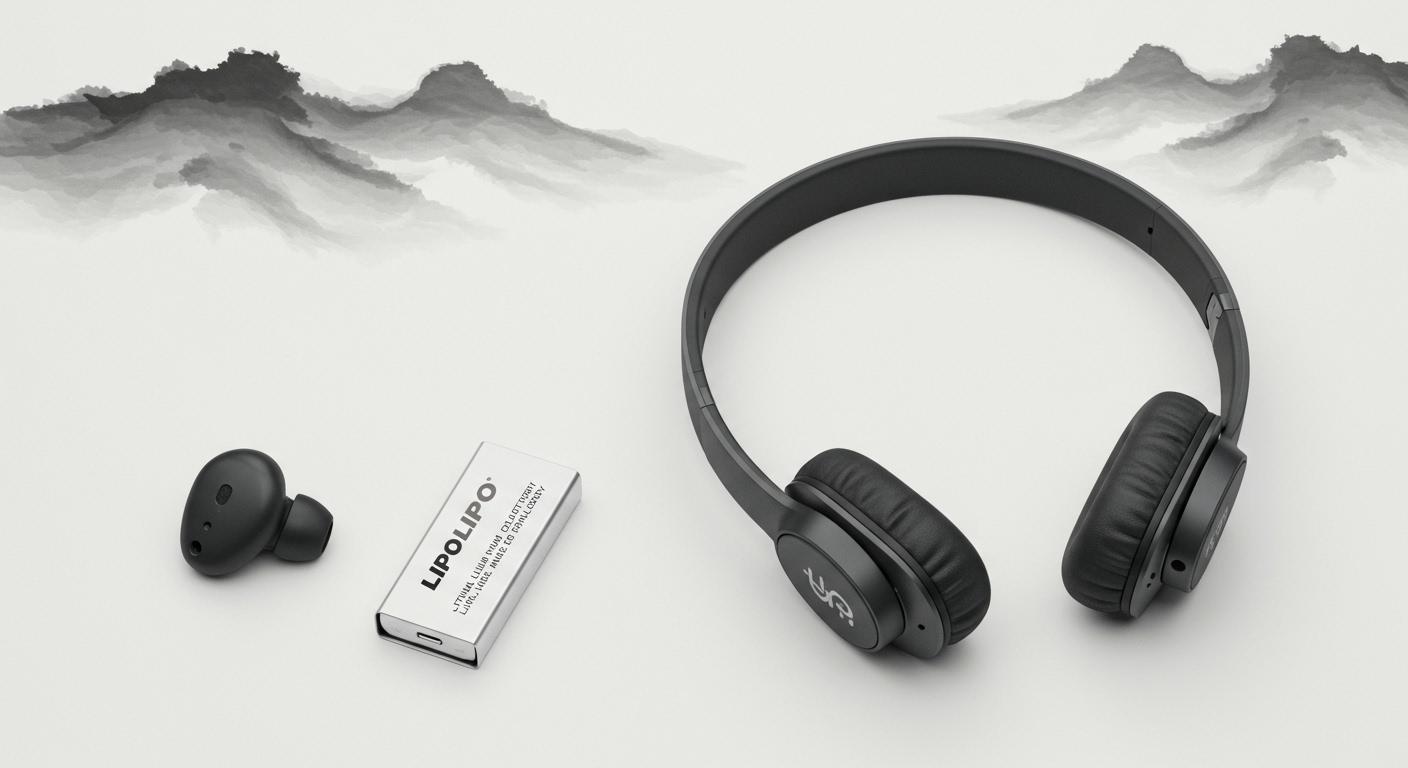Small Lipo battery for Wireless headphone market
You use a small Lipo battery when you wear wireless headphones. This battery gives power in a small and light form. It is efficient and you can recharge it many times. This makes it great for portable audio devices. Now, more people want headphones that are easy to carry. They also want to use them all day. The wireless headphone market is growing very fast:
- Market size in 2024: USD 66.97 billion
- Expected to reach USD 77.15 billion by 2025
- Projected to hit USD 317.63 billion by 2035
- Growth rate: over 12% each year through 2032
Battery technology helps add new features and better experiences for you.
Key Takeaways
- Small Lipo batteries are light and small. This makes wireless headphones easy to wear all day. Higher battery capacity lets you listen longer. But it can make headphones heavier. Safety is very important. Pick batteries that follow safety rules. This helps stop problems like getting too hot or blowing up. Fast charging lets you charge quickly. You can listen to music soon without waiting long. Eco-friendly materials are now used in headphones. These help lower harm to the environment.
Battery Requirements
Size and Weight
When you pick wireless headphones, size and weight are important. You want headphones that are light and easy to wear. A small Lipo battery helps with this. These batteries fit in small spaces. They keep headphones comfortable. Check the table below for battery models used in wireless headphones:
| Battery Model | Voltage | Capacity | Size (mm) | Weight (g) |
|---|---|---|---|---|
| LP503055 | 3.7V | 950mAh | N/A | N/A |
| 401010 | 3.7V | 25mAh | 4x10x10 | 1 |
- Bigger drivers can give stronger bass, but they add weight.
- Smaller drivers make high sounds clearer, but bass may be weaker.
- Finding the right size and weight gives you comfort and good sound.
Capacity and Voltage
Battery capacity shows how long headphones play music before charging. Most wireless headphones use a 3.7V Lipo battery. Earbuds usually have 40mAh to 60mAh. Larger headphones can have up to 950mAh. Here are some examples:
| Model | Capacity | Voltage |
|---|---|---|
| Shenzhen Chaoliyang | 60mAh | 3.7V |
| Huizhou Jiaxinrui | 40mAh | 3.7V |
| Suzhou Levin | 50mAh | 3.7V |
A bigger battery means you can listen longer. But it can make headphones heavier and larger. You need to choose between battery life and comfort.
Safety and Rechargeability
Safety matters a lot for wireless headphones. You want a battery that does not get too hot or break. Many Lipo batteries follow safety rules like IEC62133, UL 1642, and UL 2054. These rules help keep you safe from things like overcharging or short circuits.
Rechargeable batteries are helpful. You can use your headphones many times without buying new batteries. Lipo batteries charge fast and come in many shapes. They fit different headphone styles. This makes them a good choice for wireless audio devices.
Lipo Battery Benefits
High Energy Density
You want your headphones to last a long time. A Lipo battery helps because it holds lots of energy in a small space. Good lithium-ion batteries can store over 250 Wh/kg. This means you can listen longer without your headphones getting big or heavy.
- High energy density lets you listen for many hours.
- You do not have to charge your headphones often.
- The small size keeps headphones light and easy to carry.
Tip: Lipo batteries with high energy density let you listen longer and enjoy music without stopping.
Flexible Form Factor
Lipo batteries come in many shapes and sizes. This helps headphone makers design new styles for you. You can find Lipo batteries in slim earbuds, big headphones, and charging cases.
| Battery Type | Common Use Case | Design Impact |
|---|---|---|
| Li-Po | Earbuds | Slim design, lightweight profile |
| Li-ion | Over-ear headphones | Larger size, longer battery life |
A Lipo battery can be very thin or even bend. This lets companies make smaller and lighter headphones. You get more comfort and better sound because the battery fits well inside.
- Small batteries fit inside earbuds and cases.
- Tiny batteries help make modern, hidden designs.
- Flexible shapes make headphones more comfy and easy to use.
Lightweight Design
You want headphones that do not feel heavy. Lipo batteries are lighter than other types like Li-ion. This is important for wireless headphones and other wearables.
- Lighter batteries make headphones comfy for long use.
- Less weight means you can wear them all day without pain.
A small and light battery also makes headphones easy to carry. You can put them in your pocket or bag.
Consistent Performance
A Lipo battery gives steady power for many charges. You can use your headphones every day and they still work well for a long time. Most Lipo batteries last 300 to 500 charges before losing power. After 100 charges, they keep about 95% of their power. Even after 300 charges, they still have about 85% left.
- High energy density means more power in a small battery.
- Flexible shapes fit different headphone styles.
- Low self-discharge means headphones keep their charge when not used.
- Safety features help stop overcharging and short circuits.
Note: If you do not let your battery run out and keep it cool, it can last up to 30% longer.
A Lipo battery helps you enjoy good sound and long use. This makes wireless headphones a smart choice for everyday life.
User Experience
Listening Time
You want headphones that last all day. The battery inside decides how long you can listen. Many wireless headphones play music for hours, even with small batteries. Check the table to see how different models compare:
| Headphone Model | Listening Time |
|---|---|
| Best headphones for battery life in 2025 | 27 hours and 14 minutes |
| SteelSeries Arctis Nova Pro Wireless | 22 hours and 26 minutes |
| Apple AirPods Max | 21 hours |
| Master & Dynamic MW09 | 15 hours and 54 minutes |
| CMF Buds 2 | 10 hours and 22 minutes |
| Anker Soundcore Liberty 4 NC | 9 hours and 53 minutes |
| Sony WF-1000XM5 | 9 hours and 32 minutes |
| Sony WF-C710N | 9 hours and 25 minutes |

Some headphones last more than 20 hours. Others give you almost 10 hours on one charge. Battery capacity is important too. For example:
| Brand | Model | Battery Capacity (mAh) |
|---|---|---|
| Sony | WH-1000XM4 | 1045 |
| Bose | QuietComfort 35 II | 800 |
| JBL | Quantumm ONE | 750 |
A bigger battery usually means you can listen longer.
Comfort and Portability
You want headphones that feel nice and are easy to carry. The battery’s size and weight matter a lot. Studies show:
- Heavy headphones can make your head or neck hurt.
- Lighter headphones help you feel better after wearing them.
- Good weight balance makes headphones more comfy.
- Even small changes in weight can make your neck tired.
A Lipo battery helps keep headphones light. You can listen to music or talk without feeling heavy.
Fast Charging
You do not want to wait a long time to charge your headphones. Many wireless headphones now have fast charging. You get hours of listening after just a few minutes of charging. This is great if you are busy or traveling. Fast charging lets you use your headphones more and worry less about battery life.
Tip: Always use the charger that comes with your headphones. This helps keep the battery safe and working well.
Challenges
Safety Risks
It is important to know about safety risks with small LiPo batteries in wireless headphones. These batteries can get very hot. Sometimes, they might even catch fire if something goes wrong. The table below lists the main safety risks you could face:
| Safety Risk | Description |
|---|---|
| Overheating | Can cause the battery to get too hot and start a fire or explode. |
| Explosion | Rare, but can happen if the battery is damaged or made wrong. |
| Thermal Runaway | A reaction that keeps going and can make fires or explosions happen. |
Always use your headphones the way the maker tells you. Do not leave them in hot places or break them. This helps keep you safe.
Lifespan
LiPo batteries do not last forever. Over time, the battery will not hold as much charge. Most small LiPo batteries in wireless headphones last for 300 to 500 charges. After that, the battery keeps about 80% of its first power.
- Your headphones should work well for a few years if you charge them right.
- Try not to let the battery run out all the way. This helps it last longer.
Tip: Charge your headphones before the battery gets to zero. Doing this can help your battery last longer.
Cost Factors
Wireless headphones with better batteries usually cost more money. The price of LiPo batteries depends on what they are made of, how safe they are, and their size. Good batteries use better parts and have more safety checks. This makes them cost more, but they last longer and are safer.
- Cheaper headphones may have batteries that are not as good.
- Buying headphones with good batteries can save you money later.
Supply Chain
Getting enough small LiPo batteries for wireless headphones can be tough. The table below shows some big supply chain problems:
| Challenge | Description |
|---|---|
| Raw material price fluctuations | The price of things like lithium and cobalt can change and make batteries cost more. |
| Environmental concerns | Making and throwing away batteries can hurt nature. |
| Safety concerns | Making sure batteries are safe is always very important. |
Sometimes prices go up or some headphones are hard to find because of these problems. Companies try hard to fix these issues so you can buy safe and good headphones.
Lipo Battery Trends

Ultra-Thin Designs
Wireless headphones are getting thinner each year. This is because batteries are now ultra-thin. Makers use gel-like polymer electrolytes instead of liquid ones. These new batteries are lighter and bend easier. Some batteries use inorganic-polymer gel electrolytes. These are safer and work at different voltages. Other batteries use 3D garnet network composite electrolytes. These help batteries last longer.
| Advancement Type | Description |
|---|---|
| Gel-like polymer electrolytes | Slimmer, lighter, and more flexible batteries |
| Inorganic-polymer gel electrolytes | High thermal stability and strong ionic conductivity |
| 3D garnet network composite electrolytes | Longer battery life and better performance |
Ultra-thin batteries can roll and stretch. They fit into tiny spaces. This makes headphones light and comfy to wear.
Fast-Charging Tech
You want your headphones to charge quickly. Fast-charging tech helps you wait less. Normal charging takes about 2.75 hours. Rapid charging can take only 2 hours. Some batteries charge at a 0.5C ratio. This means they fill up faster. They also have a 1C discharge rate. You get steady power when you need it. Protection circuits keep charging safe.
Tip: Fast-charging lets you listen to music sooner, even if you only charge for a short time.
Eco-Friendly Materials
You care about helping the Earth. Many headphone makers use eco-friendly materials now. Some use bamboo, cherry, or beech wood. Others use materials that break down over time. Packaging is often made from recycled paper and uses safe ink. These choices help cut down on waste and protect nature.
- Bamboo and wood parts
- Biodegradable materials
- Recycled paper packaging
Smart Integration
You want headphones that do more things. Smart integration means batteries work with sensors and chips. This helps headphones check battery health and save power. The airbuds battery market is growing fast. It will reach about $1.2 billion in 2024. Over 300 million true wireless stereo devices ship each year. Companies make smaller and stronger batteries. This gives you longer listening and cool features in a small size.
Note: Making batteries smaller and smarter helps wireless headphones get better and more advanced.
Small LiPo batteries make wireless headphones lighter and safer. They also give more power. Solid polymer electrolytes help batteries bend and stay safe. This lets companies make new headphone designs. Battery technology keeps getting better. You will see thinner headphones that last longer. Watch for these things when picking headphones:
- Tiny batteries make headphones comfy
- More energy means you can listen longer
- Good safety keeps you safe
Choosing the right battery helps you enjoy music more.
-

 May.2025.11.24Ternary Lithium Battery vs Lithium-ion: Complete Comparison Guide (2025 Edition)Learn More
May.2025.11.24Ternary Lithium Battery vs Lithium-ion: Complete Comparison Guide (2025 Edition)Learn More -

 May.2025.11.214S2P 18650 14.8V Battery: Complete Technical Guide, Specs, Applications & SafetyLearn More
May.2025.11.214S2P 18650 14.8V Battery: Complete Technical Guide, Specs, Applications & SafetyLearn More -

 May.2025.11.18PCM vs BMS in Lithium Batteries: What’s the Difference and Which One Do You Need?Learn More
May.2025.11.18PCM vs BMS in Lithium Batteries: What’s the Difference and Which One Do You Need?Learn More -

 May.2025.11.17Custom Li-ion Battery Design for Medical Devices (2025 Comprehensive Guide)Learn More
May.2025.11.17Custom Li-ion Battery Design for Medical Devices (2025 Comprehensive Guide)Learn More -

 May.2025.11.17The Future of Lithium-Ion Batteries: Innovation, Sustainability, and Global Market TrendsLearn More
May.2025.11.17The Future of Lithium-Ion Batteries: Innovation, Sustainability, and Global Market TrendsLearn More
















